| It is perfectly fine with no wind this morning in sharp contrast to the
weather yesterday made us shiver with cold. Surely, today is the best day
for the outing.

Yes, we are going to visit the Temple Town in Iiyama City from now.
Lady M, a friend at Dunlop Sport Club in Urayasu and a metal chaser, had
strongly recommended this place. As a native from Nagano Prefecture, she
is familiar with the scenic and historic spots there. So, Iiyama Temple
Town is the key spot of our couple's trip this time.
We had originally planned to visit it yesterday, but such a terrible weather
like in midwinter. We suddenly changed the plan and decided to visit Zenkoji
Temple nearer and familiar to us instead of it. Our decision turned good,
so the visit to the Temple Town is going to be done today.
-----
The shuttle bus started from the hotel to Nagano Station at 8:50, arriving
there in 30 minutes.
Looking at the timetable to Iiyama Station on the local line, I found the
latest train would be at 10:27 after 1 hour. It is a waste of time.
On the newly built Hokuriku Bullet Line, Iiyama Station is next to Nagano
Station. It flashed into my mind.
I had a knowledge all right, however, I did not think of making use of
it this time.
I checked its timetable and made sure the next train would soon start at
9:32. We would probably be in time for it in a hurry.
I bought the two tickets, giving Emiko no choice in the matter and then
we hurried to the platform barely to get on the train.
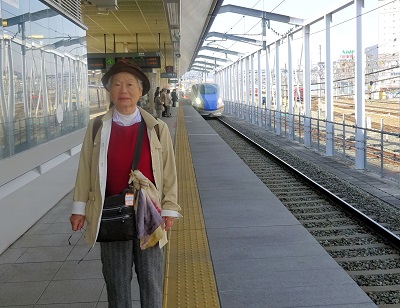
Though it takes 45 minutes by local train between Nagano and Iiyama, we
were in the bullet train only for a little more than 10 minutes and got
to Iiyama Station at 9:43.
I bragged to Emiko about my sudden judgement.
I had expected there was a tourist information office in the station all
right, but the one in Iiyama Station was superb.
I applied for the 2-hour guide tour as a perfect chance. Since the reservation
seemed to be a prerequisite for it, I thought I wouldn't be worse off for
trying.
The two lady staffs divided to call up someone about a possible position.
After a while they found a person available.
We waited for 20 minutes or so. During that time I watched the guide papers
and leaflets, and got amazed.
There are enough Japanese documents all right, but in addition there are
considerable English documents on the shelf. Iiyama is not an urban city
but local. What a surprise!
As I intend to make an English version of this travelogue someday, I felt
happy unconsciously.
-----
A lady guide appeared.
After a little talk with the staff, she led us to the outside of the station.
Well, Iiyama is the town Toson Shimazaki, a literary master, called "Snow
country's little Kyoto". It is home to many temples.
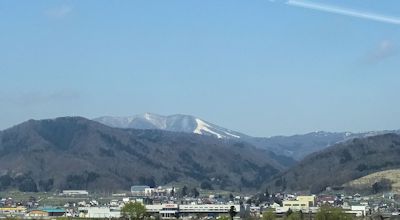
We began the temple tour with Nio-mon Gate as a starting point.
In the result, we probably visited nearly 10 temples in the following table
divided by sects.
| Sect |
|
Temple Name |
|
No |
|
|
|
|
|
Jodoshinshu
-Ohtani |
|
Hongakuji, Zenkakuji, Sairaiji,
Saikeiji, Shonenji, Sainenji,
Myosenji (Mt. Kanki) |
|
7 |
Jodoshinshu
-Honganji |
|
Shinshuji, Renshoji, Korenji,
Myosenji (Mt. Seiryu) |
|
4 |
| Soto Sect |
|
Myoshoji, Jofukuji, Daiseiji,
Eiganji |
|
4 |
| Jodo Sect |
|
Keishuji, Chuonji |
|
2 |
| Rinzai Sect |
|
Shoju-an |
|
1 |
| Shingon Sect |
|
Dairinin |
|
1 |
| Nichiren Sect |
|
Honkoji |
|
1 |
| Shrine |
|
Iikasayama Shrine |
|
1 |
|
|
|
|
|
| Total |
|
21 |
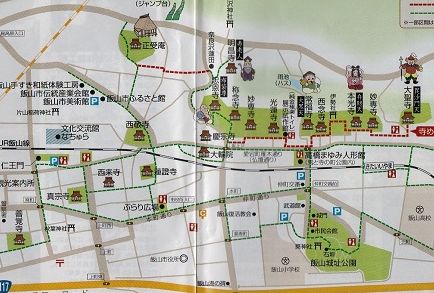
The temples could be divided to such sects as the above table. But there
is no religious discrimination, even not slightly.
So, Ms. K, the guide, had no consideration about it and just referred to
it, like "This temple belongs to Soto sect opened by Priest Dogen.
It is true it has a dojo (training hall)". Otherwise she led us and
stopped over at the temples by the fixed route.
-----
The two statues of Nio (Guardians) were shown at Nio-mon Gate. They are what I mentioned in the previous chapter.
The guideboard explains like this. I try to translate it though a little
long.
| Old Nio Statues of Zenkoji Temple |
These statues of Nio (Two Guardians) are the former Nio statues of Zenkoji
Temple, where they were enshrined at the display in Meiji 45 (1912).
At that time the original Nio statues had been burned down.
Zenkoji asked the Buddhist engravers in the neighboring temple town Iiyama
to make the temporary Nio (Guardians), and they made the two guardians
in a short period for about one month to be in time for the display.
The wooden guardian statues were taken apart after the display and carried
to a neighboring temple. However, they were left under the eaves as they
were too big to be put inside.
The priest of Shinryuji Temple in Nagano City could not be indifferent
to it. He took them back and enshrined them in its main hall in Showa 23
(1948).
In Heisei 23 (2011), thanks to the kindness of the priest Shohei Furusawa
of Shinryuji Temple, Iiyama City, took them over and displayed them as
a symbol of "Iiyama Temple Town".
For their installation, the Iiyama Buddhist Alter Project Co-op restored
and reproduced the pitch-black Nio statues.
Heisei 24 (2012) is the 100th year since they were made to be enshrined
in Zenkoji in Meiji 45 (1912).
The unusual black coloring which adds to the statues' impact is created
by Urushi lacquer.
|
| November, Heisei 24 (2012) |
| Iiyama City |
We walk along the cherry-blossom road, listening to Ms. K's explanation.

Our first visiting temple here is Shinshuji.
As the above table, it belongs to Jodoshinshu-Honganji sect opened by Priest
Shinran.
The famous writer in Meiji Period, Toson Shimazaki, visited this temple
and wrote the novel "Hakai" (Violation of a Commandment). Rengeji
in the novel is this temple.
The following is the literary monument of Toson's Hakai engraved with the
1st section of the 1st chapter.
And then Sairaiji, Renshoji, Saikyoji, ....., I must have dropped in, but
I don't remember.
Since the next day I came back home from the trip, I have been to the hospital
for rehabilitation in order to cure the back pain around the right shoulder.
After 20 days of rehabilitation, I felt like starting the travelogue and
began to arrange the photos firstly.
There are some leaflets relating to the temples, but my memory is too vague
to identify the temples. Most of their photos are not in my memory, and
what is worse, I did not take any note then there.
Besides the above-written Shinshuji, the temples I surely visited were Shoju-an, Myoshoji, Chuonji, Myosenji of Mt. Seiryu, and Korenji.
The following are these temples.
| Shoju-an Temple |
Shoju-an is the temple of Priest Shoju (Suitan), a son of the Matsushiro-clan
lord Sanada Nobuyuki. One of his apprentices is Priest Hakuin, a restorer
of Rinzai sect.
Originally built in 1666 by Dokyo, a Rinzai Buddhist monk, it was the site of his lifelong training and study.
The current temple was constructed in 1847, but original artifacts like
the stone hand washing basin still remain. |
|
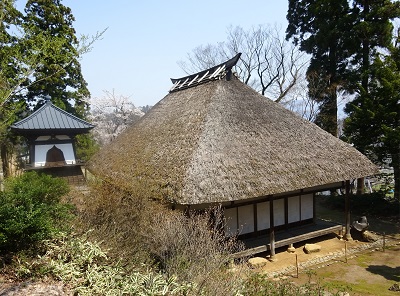 |
|
| Myoshoji Temple |
This temple is commonly known as the temple of haiku poem.
It is also the temple where Jurojin, one of the Seven Deities of Good Luck,
is deified. |
|
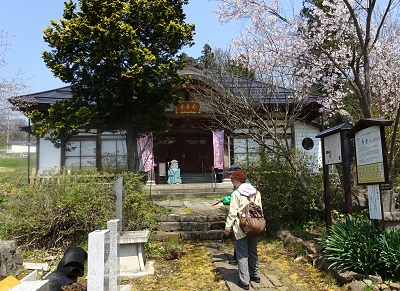 |
|
| Chuonji Temple |
The mainhall surrounded by a grove and a wonderful gabled kuri (kitchen)
shows a prestigious temple.
It is famous for the magnificent dragon picture on the ceiling.
It is also the temple where Hotei, one of the Seven Deities of Good Luck,
is deified. |
|
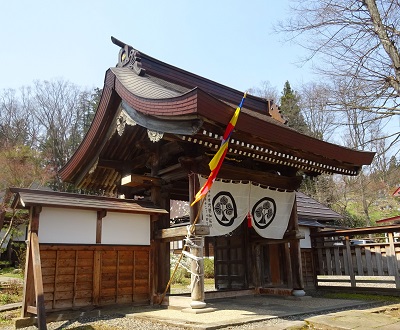 |
|
| Myosenji Temple |
| The 17th priest of this temple is Tatsujo Ichikawa who learned the one-stick
ski by Major Theodor Edler von Lerch, an Austrian, and spread it in Iiyama
district. |
|
 |
|
| Korenji Temple |
It is said this temple was built by Takeda Masayoshi, who shaved his head
to be a priest.
Takeda Unshitsu, a famous painter and poem writer in Edo period, is a priest
from this temple. |
|
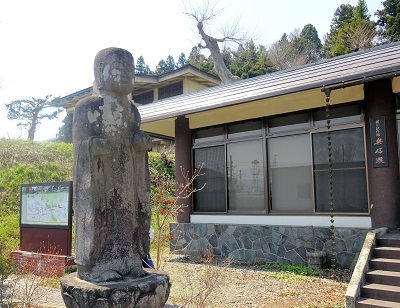 |
|
-----
We could enter the two temples, Shoju-an and Chuonji, since we had already
had the acceptance by the priests of each temple.
| Shoju-an Temple |
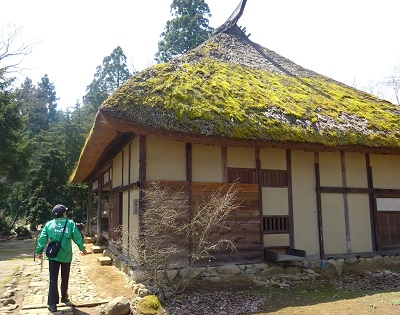 |
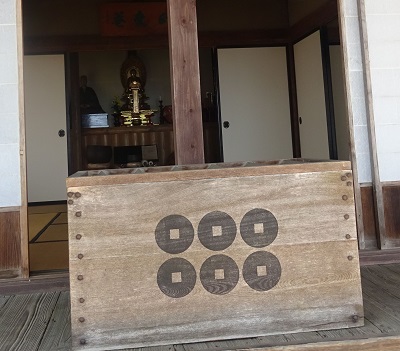 |
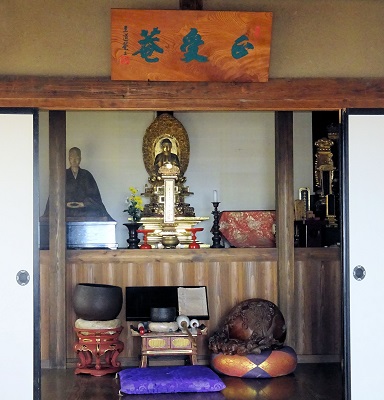 |
|
| Chuonji Temple |
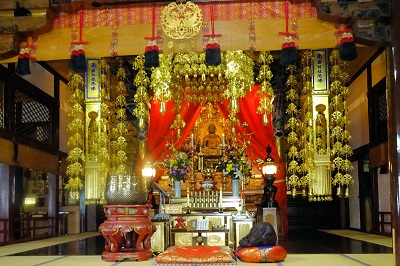 |
 |
 |
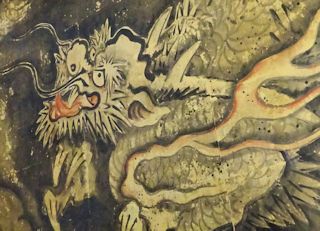 |
|
Shinshu-Iiyama tourism Bureau introduces this temple (Chuonji) like this.
|
Chuonji temple was first founded in the district of Nagano City in 1559,
and moved to Iiyama following the transfer of the then Naganuma Lord in
1601.
The main temple burned down in a large fire in 1727, and was rebuilt in
1733. In the solemn nave (open-air area) of the main temple there is a
wonderful ceiling mural of a dragon. |
|
I found good information of some other temples besides the above two in
the site of Shinshu-Iiyama Tourism Bureau. I pick up what I am interested
in as follows. (The photos are also from the site.)
| Shonenji Temple |
 |
Shonenji is known for its beautiful leaves in autumn, as well as its spectacular garden.
This temple is a prominent historic temple in Iiyama. Called Kokedera (Moss
temple) for its mossy grounds, it is famous for the exquisite contrast
between the small, but well-maintained stone garden and the beautiful colors
of its maple trees.
The best time to enjoy colorful leaves in autumn is early to mid November,
before the snowy season. However, even during the winter, temple grounds
are shoveled to allow visitors' access to the main hall. |
| Jofukuji Temple |
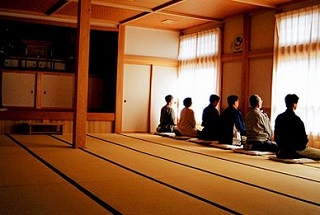 |
Jofukuji has a dojo (training hall) where interested visitors can practice
Zen meditation during the morning Buddhist service.
After borrowing a round mat and taking off any accessories, visitors may
enter the Buddhist alter room barefoot. Zen meditators all sit in one line
facing the wall. For the hour of meditation, visitors will learn to sit
with proper posture and concentrate the mind, putting all other thoughts
and concerns aside. In this way, visitors can experience one of the disciplines
of Zen Buddhism. |
| Daishoji Temple |
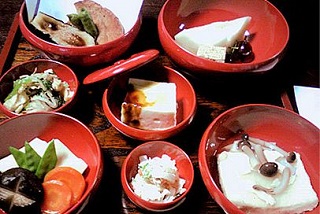 |
Daishoji offers beautiful-looking vegetarian dishes, prepared by the young
chief priest trained at Eiheiji Temple. The vegetarian dishes are available
by reservation only.
They are elaborate, original dishes, and served beautifully. Alongside
common items like sesame tofu and boiled vegetables, the temple also offers
dishes made from Iiyama-local plants and farm products.
Daishoji is also the temple where Bishamonten, one of the Seven Deities
of Good Luck, is deified. |
The Temple-Town map is as follows. Sorry not clear.

- - - - - - - - - -
Ms. K, the guide, was a member of the organization "Guide of Country Town Iiyama".
She walked at our slow pace and had an earnest and easy-to-understand explanation.
As the contract time was 2 hours, we had to leave her in front of Jofukuji
Temple.
Our couple stroll along the downtown Atagomachi street, commonly known
as Butsudan (Buddhist Alter) Street.
Shops selling Iiyama handcrafted Buddhist alters line the street. The walkways
on both sides are covered for 300 meters by a special sloping roof, called
a "gangi," designed to shelter the shops from snowfall in winter.
Near the station, I felt like to eat soba-noodle. Since we came all this
way, we looked for some good local reataurant. But no such store around
there.
I just recalled the guideboard close to the railroad minutes ago. It might
have shown a soba restaurant.
The restaurant "Rokubei" was surely open on the alley.
The inside is in the atmosphere of traditional locality.
A senior couple are drinking sake with sashimi.
A staff is proud of local dishes like "Tomikura soba" (locally-grown
buckwheat noodles) and "Sasazushi (vinegared rice with miso-pickled
radish and mountain vegetables served on a bamboo leaf).
We accepted her advice and ordered the set menu of the above written dishes.
I would like to leave a brief comment on Iiyama city in one of the guide
leaflets.
Located in the north of Nagano Prefecture, Iiyama is known as one of the
snowiest regions in Japan.
In winter, abundant snowfall and scenic ski resorts make the city a great
place for winter sports.
To learn the life and culture of Iiyama, stay at a farm-inn, or join workshops on metal carving and Japanese paper-making.
In 2015, JR Iiyama Station opened on the newly extended Hokuriku Shinkansen
line, connecting Tokyo and Iiyama directly and without transfers! |
- - - - - - - - - -
It could be realized for us to go back enjoying the pastoral landscapes
through the window of a local train, but regretfully very few train services.
So, we had to get on the 13:47 train from Iiyama Station arriving at Nagano
Station at 14:33. It means we had to wait for the 16:00 shuttle bus for
more than 1 hour.
If there had been another convenient train, we might have been able to
visit some more temples. We put our priority on the charm of a local train
as planned.
I had assumed JR Iiyama Line to be the local railway connecting Nagano
Station and Iyama Station. It was a mistake.
Its terminal on the Nagano side is actually Toyono Station, 3rd stop from
Nagano. This local railway, passing Iiyama, goes faraway to Echigo-Kawaguchi
in Nagaoka City, Niigata Prefecture. Its total length from Nagano is 96.7
km.
There are several train services of two cars to and from Nagano through
Iiyama Line taking 4 hours from Nagano to another terminal Echigo-Kawaguchi.
There are 10 round services between Nagano and Iiyama all right, but as
mentioned above, it is still not so convenient as in an urban city.
There are the following eight stations between Nagano and Iiyama.
Hachisu, Kaesa, Kami-imai, Tategahana, Shinano-asano, Toyono, Sansai and Kita-nagano.
On the way back, we enjoyed the local train viewing mountains, rice fields,
villages and cherry blossoms in a relaxed mood.
We arrived at Nagano Station a little after 14:30.

We waited for the 16:00 shuttle bus, sitting in the station's waiting room.
While I was dozing off feeling the back pain, Emiko woke me up, saying
"Now's the time."
I could not taste the French dinner enough in the hotel. Immediately after
dinner, I got back to the room and hit the sack.
|